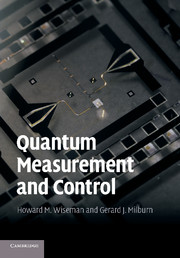Book contents
- Frontmatter
- Contents
- Preface
- 1 Quantum measurement theory
- 2 Quantum parameter estimation
- 3 Open quantum systems
- 4 Quantum trajectories
- 5 Quantum feedback control
- 6 State-based quantum feedback control
- 7 Applications to quantum information processing
- Appendix A Quantum mechanics and phase-space
- Appendix B Stochastic differential equations
- References
- Index
4 - Quantum trajectories
Published online by Cambridge University Press: 17 February 2011
- Frontmatter
- Contents
- Preface
- 1 Quantum measurement theory
- 2 Quantum parameter estimation
- 3 Open quantum systems
- 4 Quantum trajectories
- 5 Quantum feedback control
- 6 State-based quantum feedback control
- 7 Applications to quantum information processing
- Appendix A Quantum mechanics and phase-space
- Appendix B Stochastic differential equations
- References
- Index
Summary
Introduction
A very general concept of a quantum trajectory would be the path taken by the state of a quantum system over time. This state could be conditioned upon measurement results, as we considered in Chapter 1. This is the sort of quantum trajectory we are most interested in, and it is generally stochastic in nature. In ordinary use, the word trajectory usually implies a path that is also continuous in time. This idea is not always applicable to quantum systems, but we can maintain its essence by defining a quantum trajectory as the path taken by the conditional state of a quantum system for which the unconditioned system state evolves continuously. As explained in Chapter 1, the unconditioned state is that obtained by averaging over the random measurement results which condition the system.
With this motivation, we begin in Section 4.2 by deriving the simplest sort of quantum trajectory, which involves jumps (that is, discontinuous conditioned evolution). In the process we will reproduce Lindblad's general form for continuous Markovian quantum evolution as presented in Section 3.6. In Section 4.3 we relate these quantum jumps to photon-counting measurements on the bath for the model introduced in Section 3.11, and also derive correlation functions for these measurement records. In Section 4.4 we consider the addition of a coherent field (the ‘local oscillator’) to the output before detection. In the limit of a strong local oscillator this is called homodyne detection, and is described by a continuous (diffusive) quantum trajectory.
- Type
- Chapter
- Information
- Quantum Measurement and Control , pp. 148 - 215Publisher: Cambridge University PressPrint publication year: 2009



